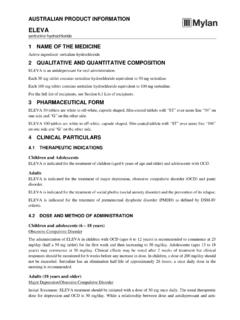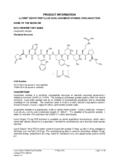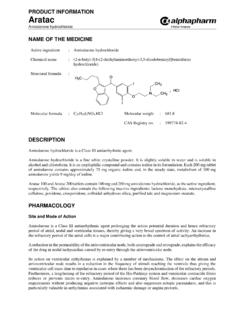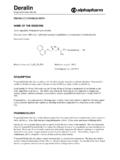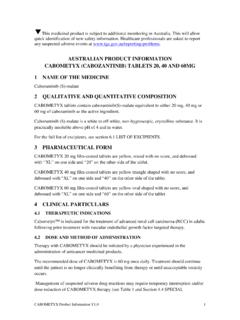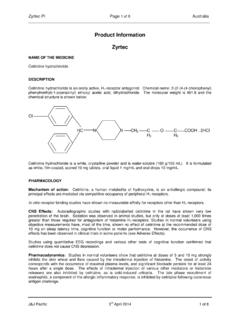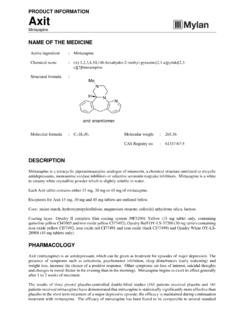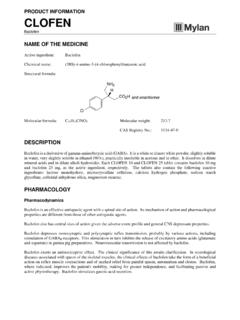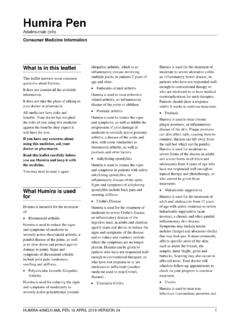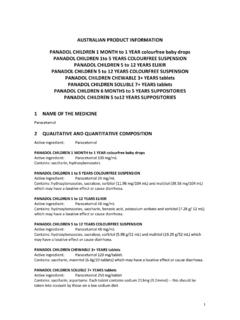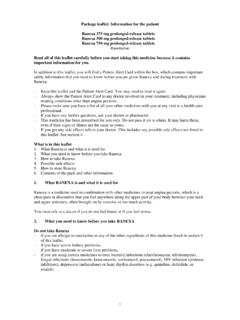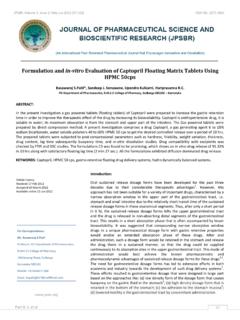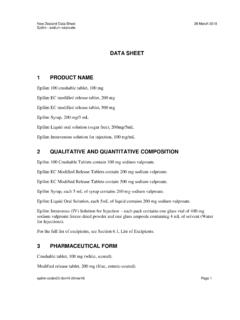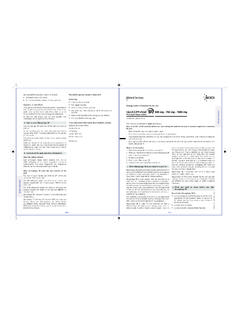Transcription of Diaformin XR Diaformin - Medicines
1 AUSTRALIAN PRODUCT INFORMATION Diaformin XR Metformin hydrochloride extended release tablets Life threatening lactic acidosis can occur due to accumulation of metformin. The main risk factor is renal impairment, other risk factors include old age associated with reduced renal function. 1 NAME OF THE MEDICINE Metformin hydrochloride. 2 QUALITATIVE AND QUANTITATIVE COMPOSITION Each Diaformin XR extended release tablet contains 500 mg of metformin hydrochloride. Diaformin XR also contains trace amounts of sulfites, for the full list of excipients, see Section List of excipients. 3 PHARMACEUTICAL FORM Oral. Metformin hydrochloride 500 mg extended release tablets : white to off-white, capsule-shaped, biconvex tablet, debossed 500 on one side. Diaformin XR is gluten free. The tablet shells may be present in the faeces. Patients should be advised that this is normal. 4 CLINICAL PARTICULARS THERAPEUTIC INDICATIONS Treatment of type 2 diabetes mellitus in adults, particularly in overweight patients, when dietary management and exercise alone does not result in adequate glycaemic control.
2 Diaformin XR may be used as monotherapy or in combination with other oral antidiabetic agents, or with insulin. DOSE AND METHOD OF ADMINISTRATION Life threatening lactic acidosis can occur due to accumulation of metformin. The main risk factor is renal impairment, other risk factors include old age associated with reduced renal function. Monotherapy and combination with other oral antidiabetic agents Initiating Therapy with Diaformin XR 500 mg For patients new to metformin, the usual starting dose of Diaformin XR is one tablet (500 mg) once daily taken with the evening meal. Diaformin XR AUSTRALIAN PRODUCT INFORMATION 2 2 After 10 to 15 days the dose should be adjusted on the basis of blood glucose measurements. A slow increase of dose may improve gastro-intestinal tolerability. Dosage increases should be made in increments of 500 mg every 10-15 days, up to a maximum of 2000 mg once daily with the evening meal.
3 Combining Diaformin XR Dosage Strengths The combined use of different strengths of Diaformin XR 500 mg or 1000 mg is not recommended. Only one strength ( Diaformin XR 500 mg or Diaformin XR 1000 mg) should be used at a time in order to avoid accidentally exceeding the recommended upper daily dose limit of 2000 mg. Switching from Diaformin XR 500 mg or Diaformin XR 1000 mg to Immediate release Metformin If glycaemic control is not achieved with the maximum recommended dose of Diaformin XR (2000 mg) or Diaformin XR 1000 (2000 mg), patients may be switched to metformin immediate release tablets to a maximum dose of 3000 mg daily. Switching from Immediate release Metformin to Diaformin XR 500 mg or Diaformin XR 1000 mg In patients already treated with metformin tablets , the starting dose of Diaformin XR 500 mg or Diaformin XR 1000 mg should be equivalent to the daily dose of metformin immediate release tablets .
4 In patients treated with metformin at a dose above 2000 mg daily, switching to Diaformin XR 500 mg or Diaformin XR 1000 mg is not recommended. Transferring from Other Oral Agents If transfer from another oral antidiabetic agent is intended: discontinue the other agent. Titration should begin with Diaformin XR 500 mg before switching to Diaformin XR 1000 mg and initiate Diaformin XR 500 mg at the dose indicated above. Combination with insulin Metformin and insulin may be used in combination therapy to achieve better blood glucose control. The usual starting dose of Diaformin XR is 500 mg once daily with evening meal, while insulin dosage is adjusted on the basis of blood glucose measurements. After titration, switch to Diaformin XR 1000 mg should be considered. Elderly Due to the potential for decreased renal function in elderly subjects, the metformin dosage should be adjusted based on renal function.
5 Regular assessment of renal function is necessary. Children In the absence of available data, Diaformin XR 500 mg and Diaformin XR 1000 mg should not be used in children. CONTRAINDICATIONS Hypersensitivity to metformin hydrochloride or to any of the excipients. Diabetic ketoacidosis, diabetic pre-coma. Renal failure or renal dysfunction (creatinine clearance < 60 mL/min). Acute conditions with the potential to alter renal function such as: - Dehydration - Severe infection - Shock Diaformin XR AUSTRALIAN PRODUCT INFORMATION 3 3 - Intravascular administration of iodinated contrast materials (see section SPECIAL WARNINGS AND PRECAUTIONS) Acute or chronic disease which may cause tissue hypoxia such as: - Cardiac failure - Recent myocardial infarction - Respiratory failure - Pulmonary embolism - Shock - Acute significant blood loss - Sepsis - Gangrene - Pancreatitis Major surgery (see section SPECIAL WARNINGS AND PRECAUTIONS) Severe hepatic insufficiency, acute alcohol intoxication, alcoholism.
6 Lactation. SPECIAL WARNINGS AND PRECAUTIONS FOR USE Lactic acidosis Lactic acidosis is a rare, but serious (high mortality in the absence of prompt treatment), metabolic complication that can occur due to metformin accumulation. Reported cases of lactic acidosis in patients on metformin have occurred primarily in diabetic patients with significant renal failure. The incidence of lactic acidosis can and should be reduced by assessing other associated risk factors such as poorly controlled diabetes, ketosis, prolonged fasting, excessive alcohol intake, hepatic insufficiency and any condition associated with hypoxia. Diagnosis: The risk of lactic acidosis must be considered in the event of non-specific signs such as muscle cramps with digestive disorders such as abdominal pain and severe asthenia. Lactic acidosis is characterised by acidotic dyspnea, abdominal pain and hypothermia followed by coma.
7 Diagnostic laboratory findings are decreased blood pH, plasma lactate levels above 5 mmol/L, and an increased anion gap and lactate/pyruvate ratio. If metabolic acidosis is suspected, metformin should be discontinued and the patient should be hospitalised immediately (see section OVERDOSE Treatment). Renal function As metformin is excreted by the kidney, it is recommended that creatinine clearance and/or serum creatinine levels be determined before initiating treatment and regularly thereafter: At least annually in patients with normal renal function, At least two to four times a year in patients with serum creatinine levels at the upper limit of normal and in elderly subjects. Decreased renal function in elderly subjects is frequent and asymptomatic. Special caution should be exercised in situations where renal function may become impaired, for example when initiating antihypertensive therapy or diuretic therapy and when starting therapy with a non-steroidal anti-inflammatory drug (NSAID).
8 Diaformin XR AUSTRALIAN PRODUCT INFORMATION 4 4 Administration of iodinated contrast materials The intravascular administration of iodinated contrast materials in radiologic studies can lead to renal failure. This may induce metformin accumulation and may expose to lactic acidosis. Therefore, metformin must be discontinued either 48 hours before the test when renal function is known to be impaired or from the time of the test when renal function is known to be normal; and may not be reinstituted until 48 hours afterwards, and only after renal function has been re-evaluated and found to be normal (see section INTERACTIONS WITH OTHER Medicines AND OTHER FORMS OF INTERACTIONS). Surgery Metformin hydrochloride must be discontinued 48 hours before elective surgery. Therapy may be restarted no earlier than 48 hours following surgery and only after renal function has been re-evaluated and found to be normal.
9 Other precautions All patients should continue their diet with a regular distribution of carbohydrate intake during the day. Overweight patients should continue their energy-restricted diet. The usual laboratory tests for diabetes monitoring should be performed regularly. Metformin hydrochloride alone does not cause hypoglycaemia; however, caution is advised when it is used in combination with other antidiabetic agents (sulphonylureas, glinides, insulin). The tablet shells may be present in the faeces. Patients should be advised that this is normal. Use in the Elderly Due to the potential for decreased renal function in elderly subjects, the metformin dosage should be adjusted based on renal function. Regular assessment of renal function is necessary (see Section DOSE AND METHOD OF ADMINISTRATION). Paediatric Use In absence of available data, Diaformin XR should not be used in children.
10 Effects on Laboratory Tests No data available. INTERACTIONS WITH OTHER Medicines AND OTHER FORMS OF INTERACTIONS Contraindicated combinations Iodinated contrast materials: Metformin must be discontinued either 48 hours before the test when renal function is known to be impaired, or from the time of the test when renal function is known to be normal (see Section SPECIAL WARNINGS AND PRECAUTIONS FOR USE - Administration of iodinated contrast materials). Diaformin XR AUSTRALIAN PRODUCT INFORMATION 5 5 Metformin should not be reinstituted until 48 hours after the test, and only after renal function has been re-evaluated and found to be normal (see Section SPECIAL WARNINGS AND PRECAUTIONS FOR USE). Inadvisable combinations Alcohol: Increased risk of lactic acidosis in acute alcohol intoxication, particularly in case of: Fasting or malnutrition, Hepatic insufficiency. Avoid consumption of alcohol and alcohol-containing medications.
